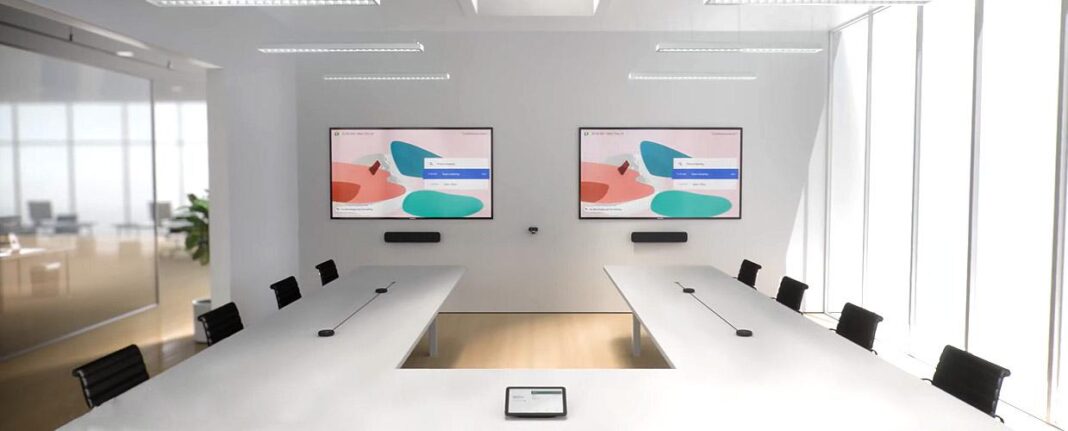Video conferencing is a critical tool for businesses of all sizes. It allows teams to collaborate and communicate more effectively, even when they’re not in the same place. A recent study by the Global Video Conferencing Market Report found that the global video conferencing market is expected to reach $151.6 billion by 2027.
There are several benefits to using video conferencing for businesses. It can:
- Save time and money on travel expenses
- Improve communication and collaboration between team members
- Build stronger relationships with clients and partners
- Provide a more inclusive work environment for remote employees
In today’s corporate and coworking spaces, video conferencing has become an essential tool for communication and collaboration. The ability to connect and engage with colleagues, clients, and partners remotely has transformed how businesses operate.
However, the quality of the video conference solutions plays a crucial role in the success of these interactions. A seamless and immersive video conference experience is vital for effective communication, boosting productivity, and fostering strong relationships. This blog will explore how technology can enhance video conferencing, the available tools, and their impact on corporate environments.
The Benefits of a Better Video Conference Experience
A good video conference experience offers several benefits to corporations and coworking spaces. Firstly, it enables teams to collaborate seamlessly, regardless of their physical locations. With the rise of remote work, video conferencing has become the lifeline that keeps teams connected and ensures smooth workflows. Effective communication through high-quality video and audio promotes better understanding, eliminates misinterpretations, and enhances overall productivity.
Moreover, video conferencing facilitates real-time decision-making, reducing the need for time-consuming in-person meetings. This saves valuable resources such as travel expenses and time, enabling businesses to allocate their resources more efficiently. Additionally, it strengthens relationships between team members, clients, and partners by providing a face-to-face connection, despite physical distance.
A better video conference experience promotes engagement, trust, and collaboration, leading to enhanced teamwork and business outcomes. Numerous factors forge a better video conference experience. We explore these in the next section.
Elevating Video Conferencing (VC) in Corporate Spaces
Corporations should account for several considerations when deciding which VC solution to deploy for their use. Some of thee
High-Quality Video and Audio Equipment: Investing in high-quality cameras, microphones, and speakers significantly improves the video conference experience. Clear visuals and crisp audio allow participants to focus on the content being shared rather than technical distractions. Popular options include cameras from Logitech and microphones from Shure.
Software and Platforms: Video conferencing software and platforms have evolved rapidly, offering a range of features to enhance the user experience. Popular platforms like Zoom, Microsoft Teams, and Google Meet provide stable connections, screen sharing, chat functionalities, and the ability to record meetings for future reference.
Intelligent Background Noise Cancellation: Background noise can disrupt conversations and reduce audio clarity during video conferences. Technologies like Krisp AI and Nvidia RTX Voice use artificial intelligence to suppress unwanted background noise, ensuring crystal-clear audio quality and focused discussions.
Smart Framing: This feature enables organisations to keep every participant fully visible and in their own frame, removing potential occlusions from other participants and maintaining a professional appearance. This is especially useful in long conference rooms where participants are sitting in a straight line across a long table and perpendicular to the cameras.
In the next section, we highlight some of the most popular enterprise video conferencing tools available to organisations along with their marquee features.
Tools for an Enhanced Video Conference Experience
Zoom: Zoom is a widely-used video conferencing platform that incorporates AI technology for various automation features. It offers intelligent framing, which automatically adjusts and frames participants within the video feed, ensuring everyone remains visible. Zoom also provides automated transcription services, allowing users to generate real-time captions during meetings. Additionally, Zoom’s recording feature includes automatic audio transcription, enabling users to review and search for specific sections of the meeting using keywords.
Microsoft Teams: Microsoft Teams is a collaborative platform that integrates AI capabilities to enhance video conferencing experiences. With its AI-powered background blur, Teams eliminates distractions by keeping the focus on the meeting participants. The platform also offers live captions and subtitles, providing real-time transcriptions of the spoken content. Moreover, Microsoft is developing an AI feature called “Dynamic View,” which automatically adjusts the layout of meeting participants, shared content, and presentations for a more engaging experience.
Google Meet: Google Meet leverages AI technology to automate various aspects of video conferencing. It includes intelligent framing, which automatically adjusts the camera view to keep participants centred and visible. Google Meet also offers real-time captions during meetings, providing automated transcription for better accessibility. Additionally, it utilises AI-powered noise cancellation to suppress background noise and enhance audio clarity.
Cisco Webex: Cisco Webex incorporates AI features to enhance video conferencing experiences. It offers automatic camera panning and framing based on audio cues, ensuring the focus remains on the active speaker. Webex also provides an automatic transcription service, generating real-time captions during meetings. Additionally, Webex Assistant, powered by AI, can provide meeting highlights and text summaries, allowing users to quickly review key points discussed in a meeting.
Otter.ai: Otter.ai is an AI-powered transcription service that can be integrated with various video conferencing platforms. It provides automated transcription and generates searchable text summaries of meetings. Users can highlight key moments, annotate transcripts, and share them with team members for easy reference. Otter.ai offers a seamless way to capture and organize meeting content, promoting collaboration and efficient communication.
BlueJeans by Verizon: BlueJeans is a video conferencing platform that utilizes AI for intelligent automation. It offers AI-powered meeting insights, which provide analytics and data-driven feedback on meeting dynamics, speaker participation, and engagement levels. BlueJeans also offers automated transcription and captioning services, making it easier to follow and reference meeting discussions.
These examples demonstrate how AI is being integrated into video conferencing tools to automate various tasks, improve accessibility, and enhance overall user experiences. As technology advances, we can expect further innovations and enhancements in automation features within video conferencing platforms.
Keeping Up with Technology
These video conferencing tools can be deployed in various settings, depending on the requirements of the organisation. In corporate boardrooms and meeting rooms, high-quality video and audio equipment, coupled with dedicated video conferencing software, ensure seamless communication during important discussions and presentations. In coworking spaces, reliable video conferencing platforms and noise-cancelling technologies enable remote workers to join meetings from shared spaces without distractions.
Staying up-to-date with the latest video conferencing technology is crucial for businesses to remain competitive and meet the evolving needs of their workforce. By embracing advancements in video conferencing tools, corporations can improve communication, collaboration, and overall productivity. Furthermore, a better video conference experience enhances the overall corporate image, making organisations more appealing to clients, partners, and top talent.















